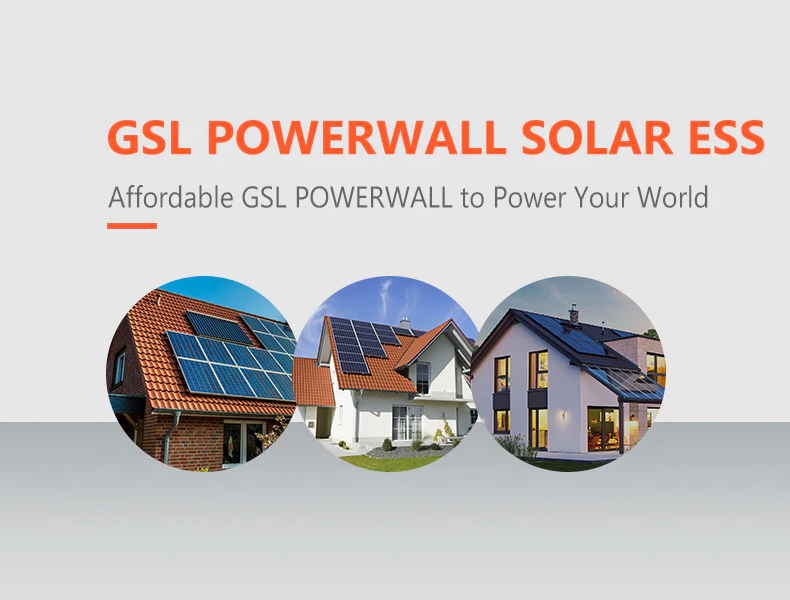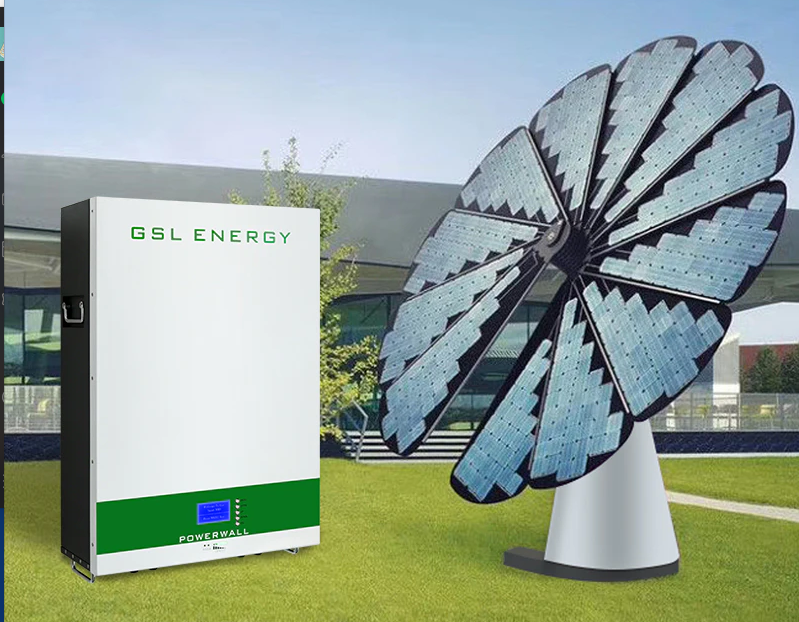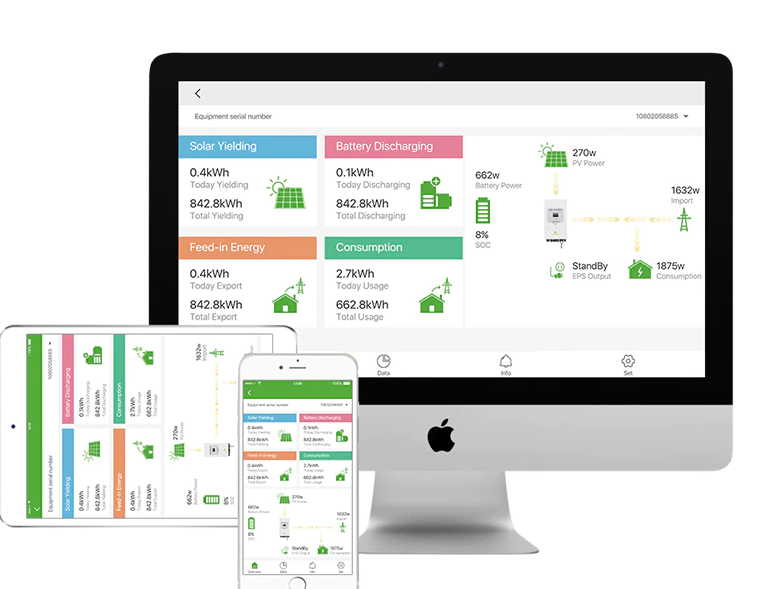Solar energy system home is generally composed of photovoltaic array composed of solar cell modules, solar charge and discharge controller, battery bank, off-grid inverter, DC load and AC load.
Photovoltaic phalanx converts solar energy into electric energy under the condition of illumination. The solar charge and discharge controller supplies power to the load and charges the battery bank at the same time.
In the absence of light, the battery bank supplies power to the DC load through the solar charge and discharge controller. Meanwhile, the battery also supplies power directly to the independent inverter, which is converted into alternating current by the independent inverter to supply power to the AC load.
Domestic solar energy system is composed of solar cells, solar controller and battery (group).
If the output power is 220V or 110V ac, an inverter is also required for solar energy system home.

Home solar energy system is a technology that converts light energy directly into electrical energy by using the photogenic volt effect at the semiconductor interface.
The key component of this home solar energy system technology is solar electricity
After the solar cells of home solar energy system are packaged and protected in series, a large area of solar cell modules can be formed, and then the photovoltaic home solar energy systemcan be formed by combining with the power controller and other components of solar energy systems for home.
The advantage of photovoltaic power from solar energy systems for home is that it is less restricted to places because the sun shines;
Photovoltaic system of solar energy storage battery also has the advantages of safety and reliability, no noise, low pollution, no consumption of fuel and the installation of transmission lines can be on-site power generation and power supply and short construction cycle.
Photovoltaic power generation from home solar energy system is based on the principle of photovoltaic effect, the use of solar cells to directly convert solar light energy into electricity.
Regardless of independent use or grid-connected power generation, photovoltaic home solar energy system is mainly composed of solar panels (modules), controllers and inverters. They are mainly composed of electronic components and do not involve mechanical parts. Therefore, home solar energy system is extremely refined, with long reliable and stable life and easy installation and maintenance.
In theory, photovoltaic technology of home solar energy system can be used for anything that needs power, from spacecraft to home power, from megawatt power plants to toys.
The most basic element of home solar energy system is the solar cell (sheet), there are monocrystalline silicon, polycrystalline silicon, amorphous silicon and thin film cells.
Single crystal and polycrystalline cells are the largest, and amorphous cells are used for some small systems and auxiliary power supply of calculator.


Home solar energy system setup
Factors to consider in the design of home solar energy system:
1. Consider environment of solar energy equipment for home and local solar radiation, etc.
2. The total power to be carried by home solar energy system and the working time of the load each day;
3. Consider the output voltage of home solar energy system and see whether it is suitable for direct current or alternating current;
4. In case of cloudy and rainy days without sunlight, the system needs continuous power supply;
5. Use of solar energy for residential also need to consider the load of household appliances, appliances are pure resistance, capacitance or sensitivity, instant start current amperage, etc.
Solar panels for residential solar energy system
Solar panels are the core part of home solar energy system generation. The role of solar panels is to convert the sun's light energy into electricity and then store the output direct current in the solar battery.
Solar panel is one of the most important components in home solar energy system power generation. Its conversion rate and service life are important factors to determine whether solar cell has use value.
Module design: Designed in accordance with international Electrotechnical Commission IEC:1215:1993, 36 or 72 polysilicon solar cells are connected in series to form 12V and 24V modules of various types, module of solar energy system can be used in various household photovoltaic systems, independent photovoltaic power stations and grid-connected photovoltaic power stations.
Features of home solar energy system raw materials:
Battery: High efficiency (16.5% or more) of the monocrystal silicon solar panel package, to ensure sufficient power generation of solar panels.
Solar panel diagram of home solar energy system
Glass: Low-iron toughened sutured glass (also known as white glass), with a thickness of 3.2mm, has a light transmittance of more than 91% within the wavelength range of solar cell spectral response (320-1100nm), and has a high reflectance for infrared light greater than 1200nm.
At the same time, the glass can withstand the radiation of ultraviolet rays from the sun, and its transmittance does not decrease.
EVA: The high quality EVA film with the thickness of 0.78mm added anti-ULTRAVIOLET agent, antioxidant and curing agent is used as the sealant of solar cell and the connecting agent between glass and TPT. It has high transmittance and anti - aging ability.
TPT: The back cover of the solar cell, fluorinated plastic film, is white and reflects sunlight, so the efficiency of the components is slightly improved. Due to its high infrared emistivities, it can also reduce the working temperature of the components, which is also conducive to improving the efficiency of the components.
Of course, the fluorinated plastic film has the basic requirements of aging resistance, corrosion resistance and air permeability as required by solar cell packaging materials.
Frame: the aluminum alloy frame has high strength and strong mechanical impact resistance.
It is also the most valuable part of home solar power.
Its role is to convert the sun's radiation capacity into electrical energy, or sent to storage batteries, or to promote the load work.
Controller for home solar energy system
The solar controller of home solar energy system is composed of dedicated processor CPU, electronic components, display, switching power tube, etc.
Main features of home solar energy system
1. Using single chip microcomputer and special software to realize intelligent control;
2. Accurate discharge control using battery discharge rate characteristic correction.
The final discharge voltage is the control point modified by the discharge rate curve, which eliminates the inaccuracy of the simple voltage control overdischarge and accords with the inherent characteristics of the battery, that is, different discharge rates have different final voltage.
3. With overcharge, overdischarge, electronic short circuit, overload protection, unique anti-reverse connection protection automatic control; The above protection does not damage any parts, does not burn insurance;
4. Adopting the main circuit of serial PWM charging, the voltage loss of the charging circuit is reduced by nearly half compared with that of the diode charging circuit, and the charging efficiency is 3%-6% higher than that of the non-PWM, thus increasing the power consumption time; Overdischarge recovery of lifting charging, normal direct charging, floating charging automatic control mode to make the system by longer service life; It also has high precision temperature compensation.
5. Intuitive LED light emitting tube indicates the current battery status, so that users can understand the use status;
6. All controls are industrial-grade chips (only for controllers with Industrial-grade I), which can operate freely in cold, high temperature and humid environment.
At the same time, crystal timing control is used, and timing control is accurate.
7. The potentiometer adjustment control set point is cancelled, and the e-side memory is used to record all working control points, so as to digitize the setting, and eliminate the factors such as the deviation of potentiometer vibration and temperature drift that make the control points appear errors and reduce the accuracy and reliability;
8. Use of digital LED display and settings, one-button operation can complete all the settings of home solar energy system, the use of extremely convenient and intuitive role is to control the working state of the entire system, and the battery has played a charge protection, over discharge protection.
In the place with large temperature difference, the qualified controller should also have the function of temperature compensation.
Other additional functions such as light control switch and time control switch should be optional for the controller.
Solar lithium battery of home solar energy system
The role of batteries is to store the electricity generated by solar panels when there is light, and release it when needed.
Solar lithium battery is the application of "battery" in solar photovoltaic power generation, mainly using lead-acid maintenance-free battery, ordinary lead-acid battery, colloid battery and alkaline nickel-cadmium battery.
Domestic widely used solar batteries are mainly: lead-acid maintenance free batteries and colloidal batteries, these two types of batteries, because of its inherent "maintenance free" characteristics and less pollution to the environment, very suitable for reliable performance of solar power systems, especially unattended work stations.
Inverter of home solar energy system
The direct output of solar energy is generally 12VDC, 24VDC and 48VDC. In order to provide electric energy to 220VAC appliances, it is necessary to convert the direct current energy generated by household solar power generation into AC electric energy. Therefore, dC-AC inverter is needed.
Home solar energy system is divided into off-grid and grid-connected solar energy systems:
1. Off-grid solar energy generation system.
It is mainly composed of solar cell module, controller and battery, and ac inverter is needed to supply power for AC load.
2. Grid-connected solar energy system means that the direct current generated by solar modules is converted into alternating current conforming to the requirements of the municipal power grid by the grid-connected inverter, and then directly connected to the public power grid.
Centralized large-scale grid-connected power stations in the grid-connected power system are generally national-level power stations, which are mainly characterized by the direct transmission of the generated power to the power grid, and the unified distribution of power to users by the grid.
However, this kind of home solar energy system is relatively difficult to develop because of its large investment, long construction cycle and large floor space.
The distributed small-scale grid-connected home solar energy system, especially the integrated photovoltaic building power generation system, is the mainstream of grid-connected power generation due to its advantages such as small investment, fast construction, small floor space and great policy support.
Advantages
1. Solar energy is inexhaustible, the earth's surface to receive solar radiation energy, to meet the global energy needs of 10,000 times. Solar energy generation system installed in 4% of the world's deserts could produce enough electricity to meet the world's needs.Solar energy generation system is safe and reliable, and will not be affected by energy crisis or unstable fuel market.
2. Solar energy can be used everywhere and power can be supplied nearby, avoiding the need of long-distance transmission, thus avoiding the loss of long-distance transmission lines;
3. Solar energy does not use fuel, low operating cost;
4. Solar energy system has no moving parts, is not easy to use and damage, simple maintenance, especially suitable for unattended use;
5. Solar energy system will not produce any waste, no pollution, noise and other public hazards, no adverse impact on the environment, is the ideal clean energy;
6. Solar energy system construction cycle is short, convenient and flexible, and according to the increase or decrease of the load, arbitrarily add or reduce the solar array capacity, to avoid waste.
Disadvantages
1. Ground application is intermittent and random. The generation of electricity is related to climatic conditions, and can't or rarely generate electricity at night or in cloudy and rainy days.
2. Low energy density. Under standard conditions, the solar radiation intensity received on the ground is 1000W/M^2. When large size is used, it needs to occupy a large area;
3. The price for solar energy system is still relatively expensive, 3~15 times of conventional power generation, and the initial investment is high.

1. Home solar energy system supply :
(1) small power supply ranging from 10-100w is used for military and civilian living in remote areas without power supply, such as plateau, island, pastoral area, frontier post and other military and civilian living electricity, such as lighting, television, radio and recorder, etc.;
(2)3-5KW domestic rooftop grid power generation system;
(3) PHOTOVOLTAIC water pump: for drinking and irrigation of deep Wells in areas without electricity.
2. Traffic fields such as navigation lights, traffic/railway signals, traffic warning/sign lights, Yuxiang street lights, high-altitude obstacle lights, expressway/railway wireless telephone booths, unattended road class power supply, etc.
3. Communication/communication field: solar energy unattended microwave relay station, optical cable maintenance station, broadcasting/communication/paging power system;
Rural carrier telephone photovoltaic system, small communication machine, soldiers GPS power supply, etc.
4. Petroleum, Marine and meteorological fields: cathodic protection solar power system for oil pipeline and reservoir gate, living and emergency power supply for oil drilling platform, Marine detection equipment, meteorological/hydrological observation equipment, etc.
5. Power supply for family lamps: such as courtyard lamps, street lamps, hand lanterns, camping lamps, climbing lamps, fishing lamps, black lights, rubber cutting lamps, energy saving lamps, etc.
Solar street Lamp map
Solar street Lamp map
6. Photovoltaic solar energy system station :10KW-50MW independent photovoltaic power station, wind-solar (diesel) complementary power station, charging station of various large parking plants.
7.Solar energy building Combines solar power generation with building materials to make large buildings self-sufficient in electricity in the future, which is a major development direction in the future.
8. Other fields include :
(1) Matching with automobiles: solar powered automobiles/electric vehicles, battery charging equipment, automobile air conditioners, ventilator, cold drink boxes.
(2) Regenerative power generation system for solar hydrogen production and fuel cell;
(3) Power supply for seawater desalination equipment;
(4) Satellites, spacecraft, space solar power station.
More info about home solar system, contact GSL, best solar energy products manufacturer in China.
Declaración de privacidad Copyright © 2018 SEHNZHEN GSL TECH CO LTD